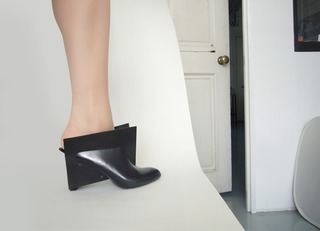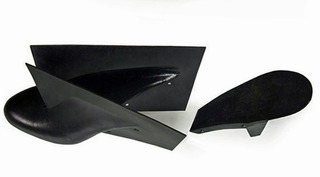'Modular' 3D Printed Shoes by Objet on Display at London's Victoria and Albert Museum
Objet Ltd. has announced that the 'Rapidprototypedshoe' from avant-garde shoe designer Marloes ten Bhömer will hit the spotlight this autumn as part of an exhibition entitled Power of Making, at the Victoria and Albert Museum, London.

Objet Ltd. has announced that the 'Rapidprototypedshoe' from avant-garde shoe designer Marloes ten Bhömer will hit the spotlight this autumn as part of an exhibition entitled Power of Making, at the Victoria and Albert Museum, London. Produced using Objet multi-material 3D printing, the Rapidprototypedshoe is designed and manufactured in a modular way so that it can be dismantled and reassembled for the purpose of replacing parts.
"My work is very much about liberating design - I use new materials and methods because this helps to break away from conventional approaches," Marloes ten Bhömer explained. "The rapid prototyping process stimulated the idea for this shoe, as the name suggests. I explored the technology and saw that rapid prototyping - adding material in layers - rather than traditional shoe manufacturing methods - could help me create something entirely new within just a few hours."
Further research led ten Bhömer to Objet's Connex range of multi-material 3D printing systems. "Objet Connex printers make it possible to print an entire shoe - albeit a concept shoe - including a hard heel and a flexible upper in one build, which just isn't possible with other 3D printing technologies," stated ten Bhömer. "The shoe is printed as a single entity so the parts come off the printer already assembled, and you can still take the shoe apart later on. It is inspiring and opens up the possibility of interchangeable heels and creating customized designs. Also, the possibility of repairs allows for a more realistic product and changes the idea of rapid prototyping into rapid manufacturing."
Objet 3D printing, which can combine rubber-like materials and rigid materials in a single prototype, is used extensively in the footwear industry. By producing more realistic prototypes and encouraging more prototyping and design iterations, Objet's 3D printing solutions enable companies to create better end-products in shorter time and at lower overall cost. Gilad Gans, Executive Vice President of Objet commented, "The highly detailed models produced by Objet provide the benefits of physically reviewing and testing designs that just can't be matched by 2D drawings. As an affordable alternative to factory-produced samples, the process encourages users to review more design alternatives, increasing the potential to produce a more creative or better designed concept."
"Cost-wise it does make sense to use Objet 3D printing, particularly for haute couture shoe design," said ten Bhömer. "I can have prototypes printed in multiple materials with no expensive set-up costs and no minimum quantities. I also have great confidence in the quality of digital prototyping - with conventional shoe mould making, the heel is matched to its left or right counterpart by eye, so there's always room for error and it can be a slow process. By making the moulds digitally you know the left and right shoes are an exact match and it's also economical and easier to scale seven different sized pairs, as required for a commercial line of shoes, using specialist software and Objet 3D printing."
Power of Making is a free V&A and Crafts Council exhibition. Curator Daniel Charny's aim is to encourage visitors to consider the process of making, not just the final results. See ten Bhömer's Objet 3D printed Rapidprototypedshoe at the Victoria and Albert Museum, London, from September 6, 2011 - January 2, 2012 and visit www.vam.ac.uk/powerofmaking for more information on the exhibition.

